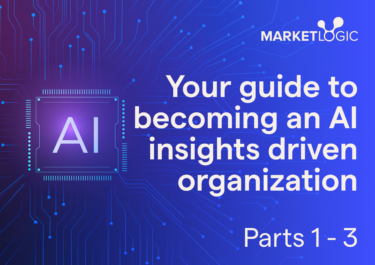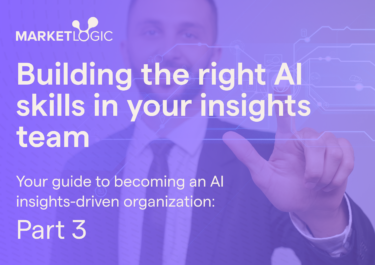
October 13, 2020
Read time: 8min

October 13, 2020
Read time: 8min
We were so pleased to have representatives from three mature global insights platforms join us on day one of Market Logic’s Insights Executives Roundtable.
Following the exciting launch and rollout presentation, we heard from Christian Niederauer, Director Strategic Insights & Consumer Affairs, Europe, at Colgate-Palmolive, as well as James Johnstone, Head of Global Customer Insights at Shell, and Joaquin Garcia-Lopez, Director, Business Analytics and Customer Insights at Johnson&Johnson.
These three leaders shared best practices in research automation and discussed how their businesses are discovering the next “new normal.”
The market insights platform at Colgate, “Driving Insights Globally,” or “DIG,” has become quite well known. That’s because, said Christian Niederauer, “for the 30 years prior to DIG, research studies were documented on pieces of paper or digital files that ended up in folders, local drives or SharePoints, and no one ever found them again.”
That’s what drove Colgate to work with Market Logic. Launched in 2016 with a focus on single sign-on to drive usage, the DIG platform expanded in 2017 to include all primary and secondary data sources, to act as the single source of truth for the entire organization.
In 2020, it’s become a global end-to-end platform that enables, among other things, the approval of a new research study with a few clicks. “We refer to DIG as our $300 mil USD platform,” said Christian, “because that’s roughly the net worth of the studies in the system!”
One of Christian’s favorite parts of DIG is its global accessibility. “Once a study is published somewhere, it’s accessible to anyone in the company,” he said. “If you’re in R&D sitting in Europe and want to know what’s happening in other parts of the world, it’s relatively easy to access it right away.”
Another cool feature, said Christian, is knowledge checks for research briefs. If the European team wants to find out the best eco-labels for packaging, they enter their research brief in DIG. Within seconds, an AI algorithm scans the entire global data for matching or related studies across the globe.
If one is available, it’s displayed on the right-hand side. If none are available, users can see similar studies and, if appropriate, apply the same kind of methodology to the new study. All in all, said Christian, “DIG helps the whole team prevent duplicated research… which is key to proving the ROI of the platform.”
Shell started working with Market Logic in 2015, and as of 2020, their retail targets are monumental: the goal is to double the business within ten years! That means there’s an enormous group of stakeholders for the insights team to work with.
To help those resource-challenged marketers reach their commercial targets, said James Johnstone, it takes a lot of thinking, a lot of time, and a lot of data.
That’s why they’ve been using Market Logic to work smarter. Automation is key – it allows them to outsource tasks that will free up their time to focus on global colleagues. Shell’s market insights platform, CI Heartbeat, is home to over 40,000 secondary sources as well as primary research documents and concept tests.
The goal is to enable marketers to self-serve themselves information, instead of requesting it from the insights team. So far, user engagement is impressive: knowledge zones are the most frequently visited parts of the platform, with 40-60% repeat visit rates. The platform provides an added bonus for marketers: no waiting time if they ask a question directly in CI Heartbeat.
When it comes to marketers commissioning research in local markets, James and his team provide guidance and support with an insights wizard. Instead of trying to stop marketers from conducting local research, the wizard guides them through the process, helping to select the best methodology and sending the completed, (best practice) research brief directly to the recommended supplier.
Once they’re ready, the supplier imports all results back into the system – so everything stays in the same place. As a result, all knowledge gained in different markets is shared, even though budgets sit locally. That also means the central insights team gets preferential terms and volume rebates, effectively providing the global organization with a bigger budget to use for new innovation projects.
The pharma industry is highly regulated and has complicated research workflows, explained Joaquin Garcia-Lopez. There are complicated laws and regulations for conducting primary market research, reaching out to physicians to patients, as well as a number of approvals that need to be in place before any market research is conducted (medical approvals, adverse events, pharmacovigilance third party due diligence, ethical approvals, privacy, etc.)
Before Johnson&Johnson launched their market insights platform, the HIVE, in 2015, market researchers had to follow detailed instructions in a 14-page document. Today, HIVE seamlessly automates these guidelines in step-by-step workflows, so nothing is overlooked. Thanks to a gradual approach of increased adoption across sectors and regions, the HIVE is now accessible across the enterprise and has made an enormous difference in the way research is conducted.
For example, said Joaquin, “we reduced our approval process for new projects. On average, it took up to 12 weeks to get a project approved in some cases. And now, we get projects approved in one to two weeks.” Streamlining research processes is transformational and innovative, said Joaquin, “and the savings that we’ve seen and the duplication that we have avoided is around 10 to 15%.”
Since the pandemic emerged, Johnson&Johnson has actively leveraged the HIVE more than ever. Telehealth trends are emerging, as well as the acceleration of clinical trials. The average product lifecycle from discovery through launch used to be 12-20 years… but COVID-19 has forced teams to consider bringing a product to market within one year.
That requires the organization to work together more quickly and more nimbly, said Joaquin, “and having a platform like the HIVE helps us keep up with that speed has been a tremendous help.” All-in-all said Joaquin, being set up as a digital insights function puts his teams in an excellent position to manage the momentous change that we’re seeing in the healthcare industry.
The days of manual, laborious research processes are slowly coming to an end, in part accelerated by industry leaders like Colgate-Palmolive, Shell, and Johnson&Johnson. Their pioneering work on research automation through insights platforms has paved the way for faster turnaround times, increased knowledge sharing, and more budget freedom.

How is AI transforming roles, skills and capabilities in insights functions?

Interview with Nextatlas CEO Luca Morena

An introduction to gen AI for businesses. From RAG to LLMs — get the lowdown.

Exploring the Future of AI in Marketing: Integrating Insights into Business Systems for Enhanced Decision-Making.

To succeed in today's dynamic consumer landscape, your organization must be able to react faster…

How does this guide help you? In part 3 of our guide, we’ll delve into…

Learn the AI insights-powered enterprise systems architecture and processes.

Transform your organization with insights. Download this guide to find out how.